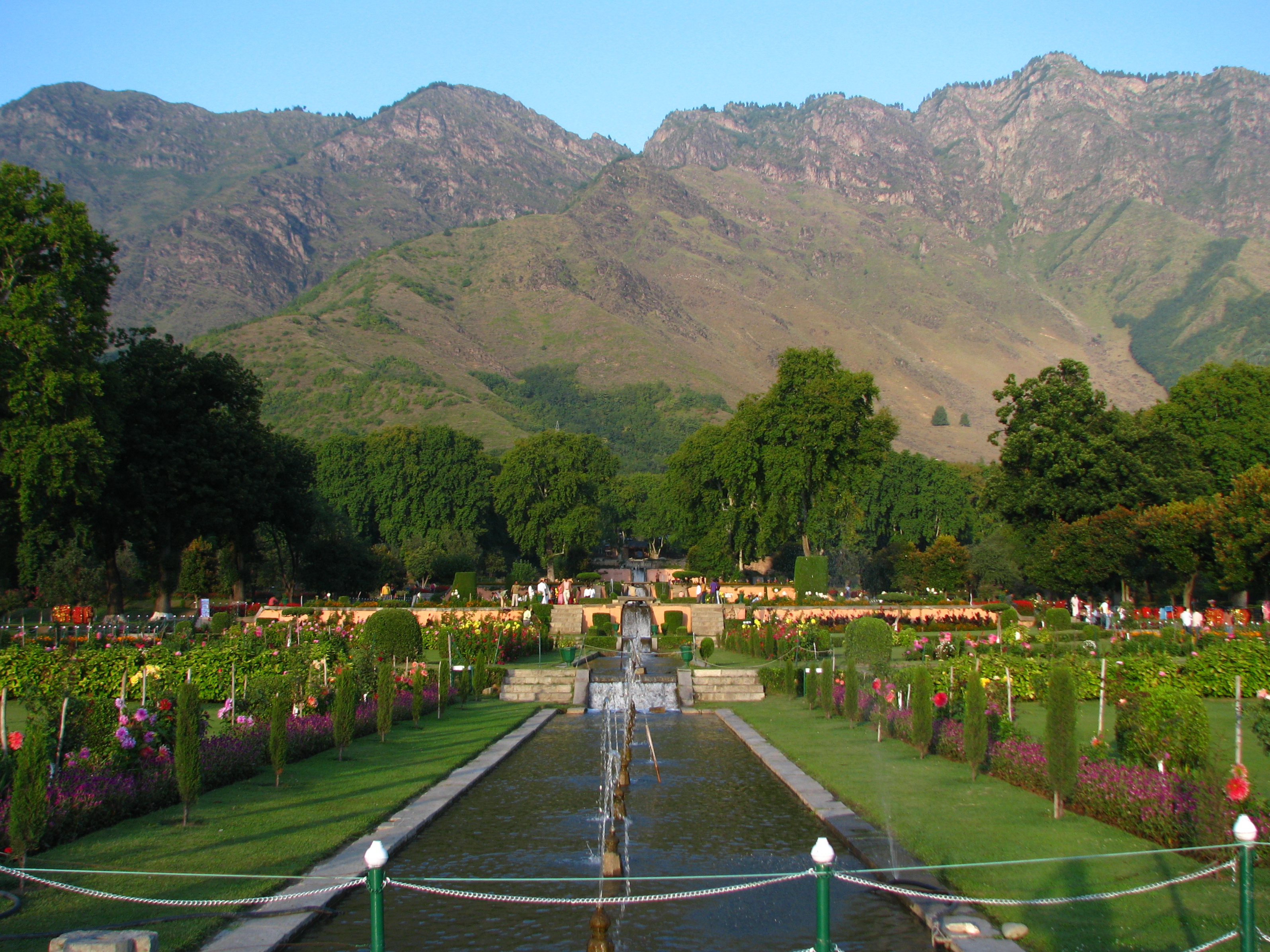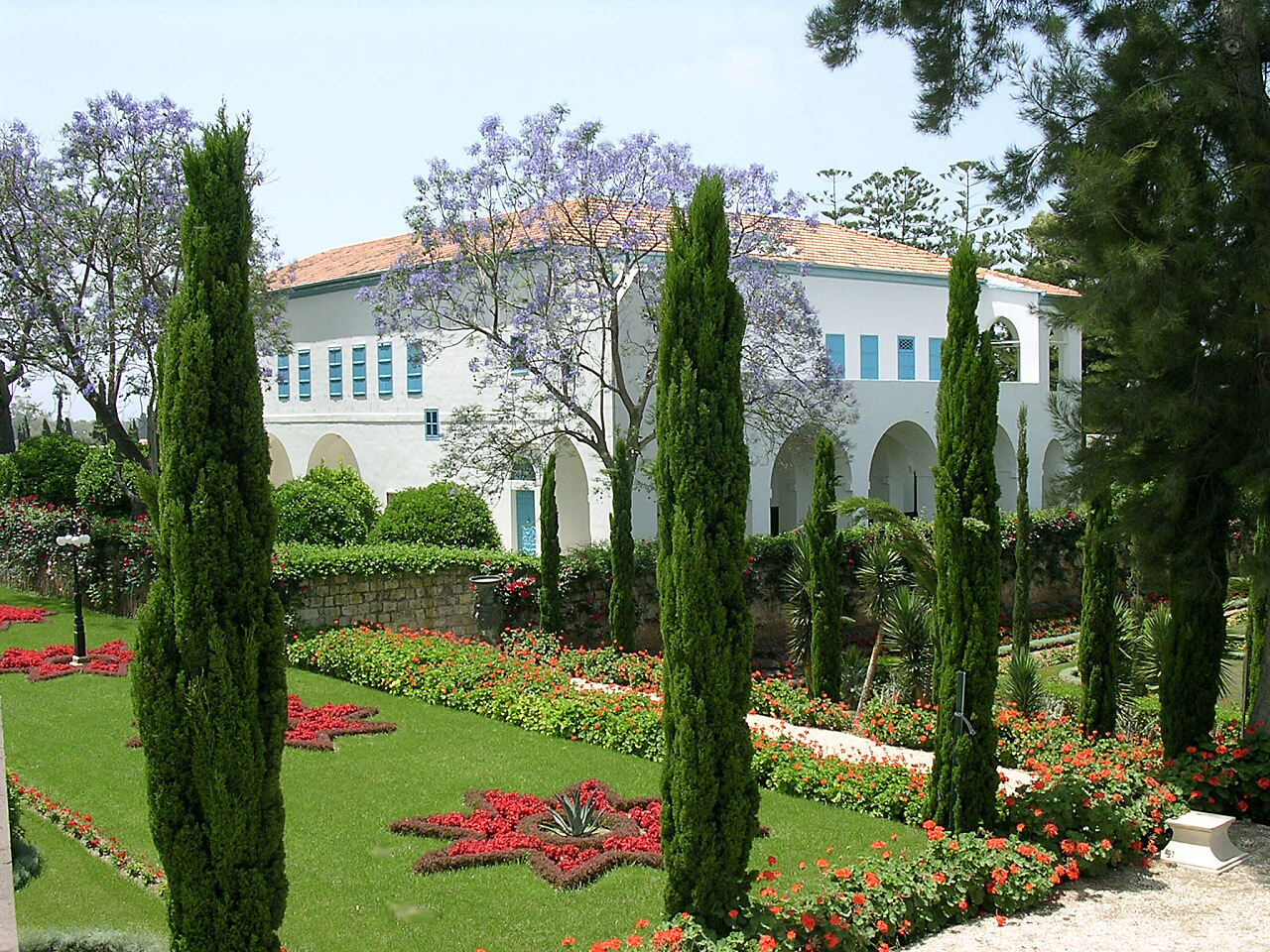|
Terraces (Baháʼí)
The Baháʼí Terraces, or the Hanging Gardens of Haifa, are garden terraces on Mount Carmel in Haifa, and one of the most popular tourist destinations in Israel. Completed in 2001, there are 19 terraces and more than 1,500 steps ascending the mountain. The central terrace has the Shrine of the Báb, one of the main religious figures of the Baháʼí Faith. The architect was Fariborz Sahba from Iran, and the structural engineers were Karban and Co. from Haifa. The terraces are part of a complex of Baháʼí holy places in Haifa, Acre, and western Galilee that were inscribed as a UNESCO World Heritage Site in July 2008. The gardens rest in the neighborhoods of Wadi Nisnas and Hadar HaCarmel. Symbolism The terraces represent the first eighteen disciples of the Báb, who were designated "Letters of the Living", although no terraces are connected with particular individuals. Design Nine concentric circles provide the main geometry of the eighteen terraces. Just as the identificat ... [...More Info...] [...Related Items...] OR: [Wikipedia] [Google] [Baidu] |
Nishat Bagh
Nishat Bagh () is a terraced Mughal garden built on the eastern side of the Dal Lake, close to Srinagar in the union territory of Jammu and Kashmir, India. It is the second largest Mughal garden in the Kashmir Valley. Nishat Bagh, is also located on the bank of the Dal Lake. ‘Nishat Bagh’ is Urdu, and means the "Garden of Joy," "Garden of Gladness" and "Garden of Delight." History Located on the bank of the Dal Lake, with the Zabarwan Mountains as its backdrop, Nishat Bagh is a garden with views of the lake beneath the Pir Panjal mountain range. The Bagh was designed and built in 1633 by Asif Khan, elder brother of Nur Jahan. An anecdote is told of the jealousy of the Emperor Shah Jahan on beholding such a delightful garden, which led to the abandonment of the garden for some time. When Shah Jahan saw the garden, after its completion in 1633, he expressed great appreciation of its grandeur and beauty. He is believed to have expressed his delight three times to Asi ... [...More Info...] [...Related Items...] OR: [Wikipedia] [Google] [Baidu] |
Persian Gardens In Israel
Persian may refer to: * People and things from Iran, historically called ''Persia'' in the English language ** Persians, the majority ethnic group in Iran, not to be conflated with the Iranic peoples ** Persian language, an Iranian language of the Indo-European family, native language of ethnic Persians *** Persian alphabet, a writing system based on the Perso-Arabic script * People and things from the historical Persian Empire Other uses * Persian (patience), a card game * Persian (roll), a pastry native to Thunder Bay, Ontario * Persian (wine) * Persian, Indonesia, on the island of Java * Persian cat, a long-haired breed of cat characterized by its round face and shortened muzzle * The Persian, a character from Gaston Leroux's ''The Phantom of the Opera'' * Persian, a generation I Pokémon species * Alpha Indi, star also known as "The Persian" See also * Persian Empire (other) * Persian expedition (other) or Persian campaign * Persian Gulf (other) ... [...More Info...] [...Related Items...] OR: [Wikipedia] [Google] [Baidu] |
Gardens In Israel
A garden is a planned space, usually outdoors, set aside for the cultivation, display, and enjoyment of plants and other forms of nature. The single feature identifying even the wildest wild garden is ''control''. The garden can incorporate both natural and artificial materials. Gardens often have design features including statuary, follies, pergolas, trellises, stumperies, dry creek beds, and water features such as fountains, ponds (with or without fish), waterfalls or creeks. Some gardens are for ornamental purposes only, while others also produce food crops, sometimes in separate areas, or sometimes intermixed with the ornamental plants. Food-producing gardens are distinguished from farms by their smaller scale, more labor-intensive methods, and their purpose (enjoyment of a hobby or self-sustenance rather than producing for sale, as in a market garden). Flower gardens combine plants of different heights, colors, textures, and fragrances to create interest and delight the s ... [...More Info...] [...Related Items...] OR: [Wikipedia] [Google] [Baidu] |
Tourist Attractions In Haifa
Tourism is travel for pleasure or business; also the theory and practice of touring, the business of attracting, accommodating, and entertaining tourists, and the business of operating tours. The World Tourism Organization defines tourism more generally, in terms which go "beyond the common perception of tourism as being limited to holiday activity only", as people "travelling to and staying in places outside their usual environment for not more than one consecutive year for leisure and not less than 24 hours, business and other purposes". Tourism can be domestic (within the traveller's own country) or international, and international tourism has both incoming and outgoing implications on a country's balance of payments. Tourism numbers declined as a result of a strong economic slowdown (the late-2000s recession) between the second half of 2008 and the end of 2009, and in consequence of the outbreak of the 2009 H1N1 influenza virus, but slowly recovered until the COVID-19 pa ... [...More Info...] [...Related Items...] OR: [Wikipedia] [Google] [Baidu] |
Bahá'í Faith In Israel
Religion in Israel is manifested primarily in Judaism, the ethnic religion of the Jews, Jewish people. The Israel, State of Israel declares itself as a "Jewish and democratic state" and is the only country in the world with a Jewish-majority population (see Jewish state). Other faiths in the country include Islam (predominantly Sunni Islam, Sunni), Christianity (mostly Melkite Greek Catholic Church, Melkite and Greek Orthodox Church of Jerusalem, Orthodox) and the religion of the Druze, Druze people. Religion plays a central role in national and civil life, and almost all Israeli citizenship law, Israeli citizens are automatically registered as members of the state's Millet (Ottoman Empire)#Post-Ottoman use, 14 official religious communities, which exercise control over several matters of personal status, especially Marriage in Israel, marriage. These recognized communities are Orthodox Judaism (administered by the Chief Rabbinate of Israel, Chief Rabbinate), Islam, the Druze faith ... [...More Info...] [...Related Items...] OR: [Wikipedia] [Google] [Baidu] |
Tourism In Israel
Tourism in Israel is one of Israel's major sources of income, with a record 4.55 million tourist arrivals in 2019, and, in 2017, contributed NIS 20 billion to the Israeli economy making it an all-time record. Israel offers a plethora of historical and religious sites, beach resorts, natural sites, archaeological tourism, heritage tourism, adventure tourism, and ecotourism. Israel has the highest number of museums per capita in the world. For practical reasons, this article also covers tourism in the Israeli-occupied West Bank and the occupied Golan Heights, since it is closely interconnected with the mass tourism in Israel. In 2017, the most popular paid tourist attraction is Masada. The most visited city was Jerusalem and the most visited site was the Western Wall. The largest percentage of tourists came from the United States accounting for 19% of all tourists, followed by Russia, France, Germany, the United Kingdom, China, Italy, Poland, and Canada. Religious tourism is v ... [...More Info...] [...Related Items...] OR: [Wikipedia] [Google] [Baidu] |
Shrine Of Baháʼu'lláh
The Mansion of Bahjí ( ar, قصر بهجي, Qasr Bahjī, ''mansion of delight'') is a summer house in Acre, Israel where Baháʼu'lláh, the founder of the Baháʼí Faith, died in 1892. He was buried in an adjacent house, which became the Shrine of Baháʼu'lláh, a place of pilgrimage and the Baháʼí Qiblih. The whole area was called ''Al-Bahjá'' (''Place of Delight''). Mansion of Bahjí Baháʼu'lláh's son ʻAbdu'l-Bahá first rented, and then purchased, the mansion for his father and the Baháʼí holy family to live in, and Baháʼu'lláh moved from Mazra'ih to Bahji and resided in the building until his death. In 1890 the Cambridge orientalist Edward Granville Browne met Baháʼu'lláh in this house; after this meeting he wrote his famous pen-portrait of Baháʼu'lláh. When Baháʼu'lláh died in 1892 he was interred in one of the surrounding buildings. The site has since been beautified with paradise gardens, which are termed ''Haram-i-Aqdas'' (the Most Holy Prec ... [...More Info...] [...Related Items...] OR: [Wikipedia] [Google] [Baidu] |
Amram Mitzna
Amram Mitzna ( he, עמרם מצנע, born 20 February 1945) is an Israeli politician and former general in the IDF. He is a former mayor of Haifa (1993–2003) and Yeruham (2005–2010) and led the Labor Party from 2002 to 2003. In 2012 he joined Hatnuah. Youth, education, and military service He was born in Kibbutz Dovrat to Jewish refugees that escaped from Nazi Germany. He attended a military boarding school in Haifa, graduating from the Hebrew Reali School in 1963 and enlisting into the IDF the same year. He served in various positions in the IDF armored force, the Command and Staff College, and the Operations Division in the General Staff, receiving the Medal of Distinguished Service for his actions during the Six-Day War and the Yom Kippur War, both of which saw him wounded. In 1977 he graduated from the University of Haifa with a degree in geography, before studying at the U.S. Army War College in Pennsylvania, finishing his course in 1979. In 1986 he was promoted to ma ... [...More Info...] [...Related Items...] OR: [Wikipedia] [Google] [Baidu] |
Irrigation System
Irrigation (also referred to as watering) is the practice of applying controlled amounts of water to land to help grow crops, landscape plants, and lawns. Irrigation has been a key aspect of agriculture for over 5,000 years and has been developed by many cultures around the world. Irrigation helps to grow crops, maintain landscapes, and revegetate disturbed soils in dry areas and during times of below-average rainfall. In addition to these uses, irrigation is also employed to protect crops from frost, suppress weed growth in grain fields, and prevent soil consolidation. It is also used to cool livestock, reduce dust, dispose of sewage, and support mining operations. Drainage, which involves the removal of surface and sub-surface water from a given location, is often studied in conjunction with irrigation. There are several methods of irrigation that differ in how water is supplied to plants. Surface irrigation, also known as gravity irrigation, is the oldest form of irrigati ... [...More Info...] [...Related Items...] OR: [Wikipedia] [Google] [Baidu] |
English Gardens
The English landscape garden, also called English landscape park or simply the English garden (french: Jardin à l'anglaise, it, Giardino all'inglese, german: Englischer Landschaftsgarten, pt, Jardim inglês, es, Jardín inglés), is a style of "landscape" garden which emerged in England in the early 18th century, and spread across Europe, replacing the more formal, symmetrical French formal garden which had emerged in the 17th century as the principal gardening style of Europe. The English garden presented an idealized view of nature. Created and pioneered by William Kent and others, the “informal” garden style originated as a revolt against the architectural garden and drew inspiration from paintings of landscapes by Salvator Rosa, Claude Lorrain, and Nicolas Poussin.Bris, Michel Le. 1981. ''Romantics and Romanticism.'' Skira/Rizzoli International Publications, Inc. New York 1981. 215 pp. age 17Tomam, Rolf, editor. 2000. ''Neoclassicism and Romanticism: Architecture, ... [...More Info...] [...Related Items...] OR: [Wikipedia] [Google] [Baidu] |







.jpg)